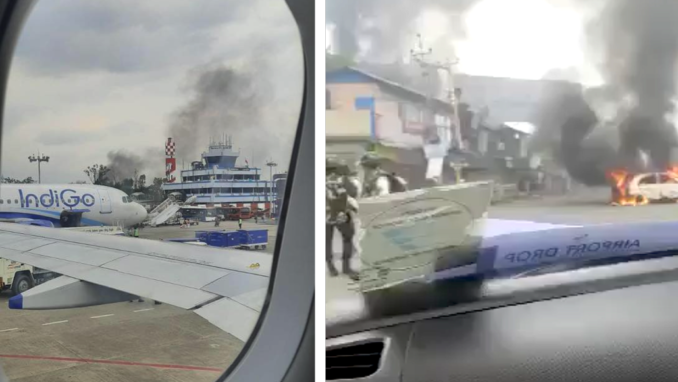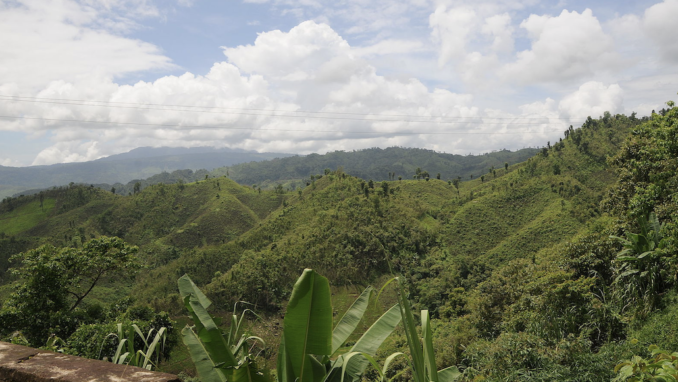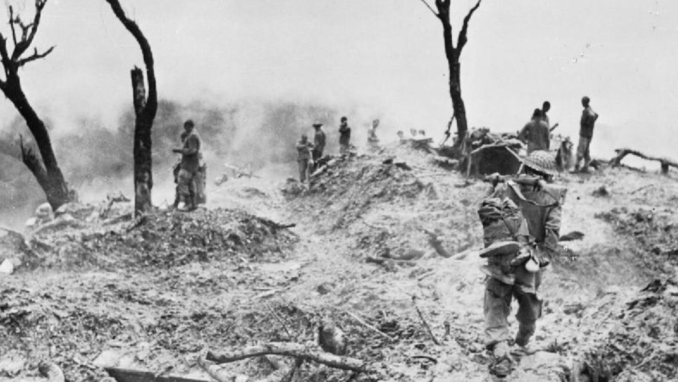In seach of a hidden gem
“Lucky bugger,” muttered Swiss Bob as he sat beside the log fire at the staff end of the Explorer’s Room in the exclusive Going Post Gentleman’s (Ladies welcome) Club on Pall Mall. On the other side of the net curtains and Georgian sash windows, the light drizzle of a still midnight was interrupted by the clippety-clop of a thousand cavalry horses and their mounts rehearsing for the Coronation parade. Through his grin, the Boss confided he could do with a holiday himself but, pet to feed, that kind of thing. Can’t be helped. Never mind.
With that wonderful thing called hindsight one’s obliged to make an observation. Thinking back to the firelight gloom beneath G-P’s famous pin-covered tapestry of the world (beside a Puffins’ postcard shelf threatening to buckle under the weight of adventure), one is reminded to be careful about what one wishes for.
The omens had been present. En route to rendezvous with the airport shuttle, while pushing through drills of rehearsing guardsmen, a full moon sneered from above the Palace of Westminster. Not only that, as Big Ben’s chimes topped the hour, were there thirteen?
Added to which it’s never a good sign when the airline collapses while you’re stretching your legs in the transit lounge at Abu Dhabi International. Not to worry. Bank of AWS to the rescue. Got there in the end. Neither does it bode well when a gentleman’s destination airport is on fire when he finally arrives there.

© Always Worth Saying 2023, Going Postal
Forty-eight hours and four time zones from Pall Mall, acrid smells and rising plumes of dark smoke announce Blighty and her comfy late-night leather-bound chairs to be a full 5,000 miles distant. The previous day, while in transit, the natives had started slaughtering each other between taking time out to set fire to the airport. Who they, I hear you ask. Why, the Maipuris of course, although, as we shall see, one cohesive homogenous people they are not.
Manipur: A hidden gem in North East India

Mountains Scenery Manipur India,
Sharada Prasad CS – Licence CC BY-SA 2.0
Nestled in the northeastern corner of India, Manipur is a land of mesmerizing beauty and rich cultural heritage. Often referred to as the “Switzerland of India,” this is a hidden gem of lush green landscapes and fascinating history.
Bordered by Nagaland to the north, Mizoram to the south, and Assam to the west, to its east lies an international border with Myanmar/Burma. At the closest point, Bangladesh is only 75 miles in the opposite direction. China and Bhutan rest 200 miles to the northeast and northwest respectively. With a population of over 2.7 million people, Manipur is home to a diverse array of ethnicities and tribes, each with unique cultural practices and traditions as a result of centuries of numerous migrations and invasions.
The early history of Manipur is marked by the rule of the Meitei kings, who established their Hindu kingdom in the region around the 1st century AD. The kingdom of Manipur reached its zenith during the 15th and 16th centuries, under the rule of the Ningthouja dynasty. During this period, the kingdom expanded its territories and established diplomatic relations with neighbouring states, including the powerful Ahoms of Assam.
The 18th and 19th centuries were tumultuous times, marked by invasions from the Burmese and the British East India Company. In 1891, Manipur was formally annexed by the British, becoming a princely state within British India. It was during this period that the modern boundaries of Manipur were established, with ourselves creating a demarcation between the hills and the valley regions to maintain peace between the various ethnic and religious groups. The hill people being Christian and those of the valley, Hindu.
Imphal: A historied capital

Dusk times at Imphal City,
Ritezh Thoudam – Licence CC BY-SA 2.0
Imphal, the capital city of Manipur and the home of the state’s international airport, is located in the heart of the Manipur Valley and is surrounded by lush green hills, ordinarily providing a picturesque setting for fortunate visitors.
The history of Imphal dates back to ancient times, with the city serving as an important administrative and cultural centre for the Meitei kings.
Today, Imphal should be a bustling city. Normally a population of over 250,000 people offers a unique blend of modernity and tradition. However, as I type it is shuttered. The streets are deserted. A curfew is in force. The internet and telephone communication are disconnected. The city’s historical sites and monuments are deserted. Kangla Fort, which was once the seat of power for the Meitei kings is empty. Imphal’s numerous markets, including the Ima Keithel, or “Mother’s Market,” which is operated entirely by women and is believed to be the largest all-women market in Asia, are abandoned and feared looted.

© Always Worth Saying 2023, Going Postal
The area is no stranger to conflict. Over the centuries, Imphal has witnessed numerous invasions and battles, including the infamous Battle of Imphal during World War II.
The Battle of Imphal: A turning point in WW II
Fought between the British Indian Army and the Japanese forces in 1944, this was a significant turning point in the war. The battle marked the then largest defeat of Imperial Japan, ultimately forcing the Empire of the Sun to retreat from the region and abandon their plans to invade India.
Hostilities began in March 1944, when the Japanese launched an offensive to seize the city and cut off the supply lines of the British Indian Army. Over the course of several months, the two sides engaged in brutal combat, with both suffering heavy casualties. The harsh terrain and weather conditions only added to the challenges faced by the soldiers.
Ultimately, the British Indian Army, aided by the local Manipuri population, managed to hold off the Japanese forces and drive them out of the region. The Battle of Imphal is considered one of the most significant battles in the history of the British Indian Army and played a crucial role in shaping the outcome of the war in the Far East.

Battlefield on Scraggy Hill at Shenam,
No.9 Army Official photographer – Public domain
Although much is made of the Indian contribution to the British war effort by a UK mainstream media sensitive to our own country’s racial sensitivities, the converse was also the case. Large numbers of British military were diverted from the war effort to contain the activities of various Indian nationalist organisations, not least that led by troublemaker Mahatma Gandhi. At Imphal the confrontation was more direct. The anti-British Provisional Government of Free India, or Azad Hind, recruited from Indian prisoners of war in Japanese-occupied Burma and Singapore and formed a fighting force of upwards of 40,000 men who fought alongside the Japanese. Although defeated, the historical attitude towards them remains ambiguous.
Azad Hind was established by Indian nationalist leader Subhas Chandra Bose during World War II. Manipur region played a pivotal role in the activities of the Azad Hind in their ambition to ‘liberate’ India from British rule by launching an armed struggle against the British Indian Army. Manipur served as a key base for the Azad Hind, with Bose himself visiting the region to rally support for the cause.
While the Azad Hind ultimately failed to achieve their type of Indian independence, its activities in Manipur and elsewhere played a significant role in shaping a broader struggle aimed at ending British rule. In accordance, their activities are remembered, and at times are honoured, to this day.
Manipur today: Torn by sectarian violence
In the years since India gained independence from British rule, the guidebooks insist Manipur has emerged as a vibrant and diverse state with a unique cultural identity. The region is home to numerous indigenous tribes and ethnic groups, each with its own distinct customs, traditions, and languages. The guidebook omits to mention the sectarian violence that occasionally arises between them.
The economy of Manipur is primarily agrarian, with agriculture serving as the main source of income for the majority of the population. The state also has a growing industrial sector, with occupations such as handloom and handicrafts, horticulture, and food processing playing an increasingly important role in the local economy.
Up until the events of the last few days, tourism was another key industry, with the state’s stunning natural beauty and rich cultural heritage attracting visitors from around the world. From the picturesque landscapes of the Loktak Lake to the cultural festivals of the indigenous tribes, Manipur offered a wealth of experiences for travellers seeking to explore a hidden jewel of Northeast India.
By the end of the first week of May 2023, those tourists, mainly American, were pinned down in what appeared to be Imphal’s one remaining open hotel. Roads were too dangerous to use. The military were thought to be prioritising local Christians to the airport, the assumption being tourists are less likely to be targeted by Hindu mobs.

© Always Worth Saying 2023, Going Postal
The communal violence began on Wednesday 3rd May and quickly spun out of control. Although in the majority and generally more prosperous and better educated than the Christian mountain tribes, Manipur’s BJP state government and the courts are pushing to grant the Hindu Maitai people ST status. The BJP are the Hindu nationalist party of Indian President Mr Narendra Modi. ST is the Scheduled Tribe system of ‘positive discrimination’ and so-called ‘affirmative action’ which would guarantee the Maitai quotas of government jobs and college admissions.
The Deccan Herald reports that fighting broke out during a resulting All Tribal Students Union protest march in the tribal-dominated Churachandpur district. Hindus were targeted.
Across the state, Hindus attacked Christians. By May 8th, the Herald was reporting that at least 60 people had been killed and over 200 injured. 1,700 dwellings have been burned by rioters and over 20,000 Christians have been displaced from their homes. Dispatches from elsewhere suggested dozens of churches have been torched and that the actual death toll may be much higher. In the chaos, thousands of weapons have been snatched from the security forces.
Also on the 8th May, Biren Singh, the Chief Minister of Manipur, announced 105 columns of Army and Assam Rifles and 50 companies of central paramilitary forces have been deployed to the vulnerable areas with evacuees moved to camps and put under military protection. The ban on mobile and broadband internet will be extended until May 13. The curfew will be lifted for a few hours daily to allow people to shop for food.
As with our own country’s racial tensions, the central government prefer to pretend it isn’t happening. India’s Home Minister, Amit Shah, is said to have no plans to visit. As for the stranded tourists and postcard authors, late weekend flights allowed many to escape to neighbouring Assam – while attempting some secret filming with sweaty palms and shaking hands.
© Always Worth Saying 2023



